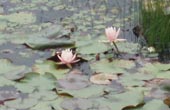
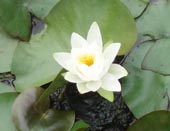
Fragrant Water
Lily (Nymphaea odorata) Pink and White forms: A floating
aquatic with fragrant white or pink flowers. Found in calm
water. Blooms June - September. Location: Black Moshannon
SP, PA.
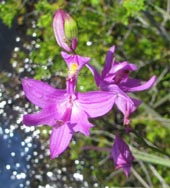
Grass Pink
Orchid or Colopogon (Colopogon pulchellus): One
basal leave clasps the stalk. Found in bogs and swamps.
Photo by Dimitri Tundra.
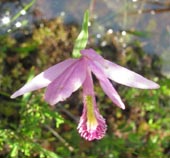
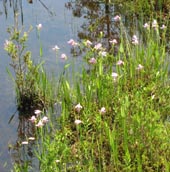
Rose Pogonia (Pogonia
ophioglossoides): A single flower and one mid-stem
clasping leaf. Another bog orchid. Photo by Dimitri Tundra.
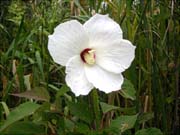
Crimson-eyed Rose Mallow (Hibiscus palustris
forma peckii): Blooms
July to September in marshes. Can grow to 7 feet tall.
Location: Jug Bay, Patuxent River, MD. Photo by Ken Clark.
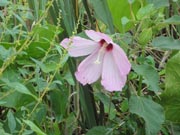
Swamp Rose
Mallow
( Hibiscus
palustris): Similar to above but with pink petals.
Location: Jug Bay Wetlands Sanctuary, MD.
|
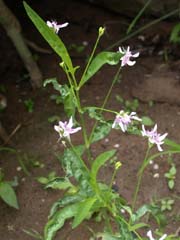
American Water Willow (Justicia
americana): Small white flowers with orchid/purple
markings. Grows along banks of streams, rivers and lakes.
Roots are always submerged. Location: Potomac River, Great
Falls National Park. Photo by Ken Clark.
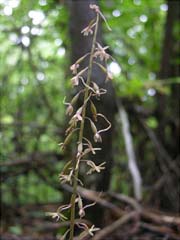
Cranefly Orchis (Tipularia discolor): Green-brown
flowers on a leafless stalk. Grows in swampy areas. A single
broad, lanceolete leaf sprouts in the fall and winters-over
to wither away in the spring. Location: Jug Bay, Patuxent
River, MD. Photo by Ken Clark.
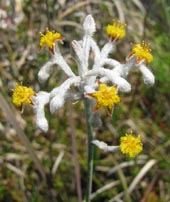
Golden
Crest (Lophiola aura): A bog plant of the east coast
from New Jersey south to Florida. Photo by Dimitri Tundra.
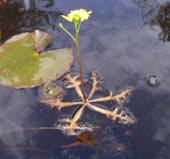
Swollen
Bladderwort (Utricularia inflata): Note the swollen
leaves that act as floats. Photo by Dimitri Tundra.
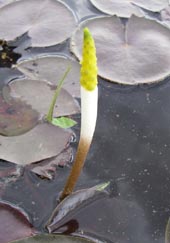
Golden Club
(Orontium aquaticum): The clublike spadix is covered
with tiny yellow flowers. Photo by Dimitri Tundra. |
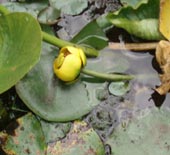
Bullhead Lily (Nuphar variegatum):
Tough, leathery cup-like flowers. Leaves and flowers float. Blooms May - September.
Location: Black Moshannon SP, PA.
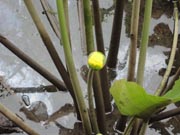
Spatterdock
(Nuphar advena): Similar to Bullhead Lily (above) but
leaves and flowers are erect and above the water level.
Location: Jug Bay Wetlands Preserve, MD.
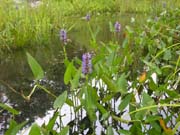

Pickerelweed (Pontederia
cordata): A true aquatic. Can grow 2-3 feet tall.
Location: Billy Goat Tr, Great Falls NP, MD. Photo by Ken
Clark.
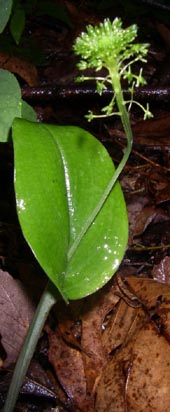
Green
Adder's-Mouth (Malaxis unifolia): Note the single
mid-stalk leaf. Woods, bogs and swamps. Photo by Dimitri
Tundra.
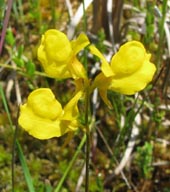
Horned
Bladderwort (Utricularia cornuta): Note the horns on this
aquatic. Photo by Dimitri Tundra. |
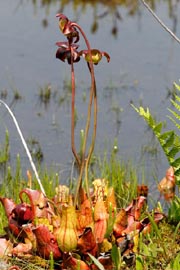
Northern
Pitcher Plant (Sarracenia purpurea): Carnivorous!
Height 8 to 24 inches. Leaves up to 12 inches. Each plat has
a large leathery crimson flower with 5 petals dangling over
the basal leaves. Leaves veined deeply red, inflated and in
the shape of a pitcher. The flower attracts insects which
fall into the "pitchers" which are partially full with
water. Inverted hairs on the leaf surface prevent their
escape. The plant extracts the nutrients from the water as
the insect decomposes. Photo by Marc Shaffer.

Spiked Purple
Loostrife (Lythrum salicaria): An escaped ornamental
capable of quickly covering vast wetland areas. Photo by
Dimitri Tundra.
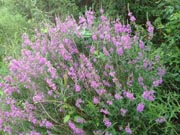
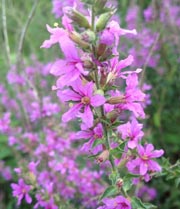
Purple
Loosestrife (Lithrum virgatum): Alien. Similar
to L. salicaria except the flowers are mostly in the leaf
axils. |
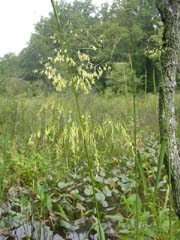
Wild
Rice (Zizania aquatica): Grows in wetlands. Can reach
a height of 9 feet. Simple white flowers on upper, erect
branches are female. Flowers on drooping, lower branches are
male. The grain is edible. Location: Jug Bay, Patuxent
River, MD. Photo by Ken Clark.
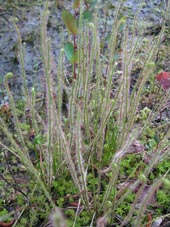
Thread-leaved Sundew (Drosera filiformis): Small puple
flowers and long sticky leaves make tis bog plant easy to
identify. Photo by Dimitri Tundra.
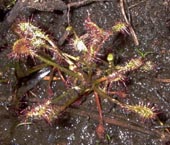
Spatulate-leaves
Sundew (Drosera intermedia): Leaves are longer than
the Round-leaved Sundew that follows. Mostly found on the
coastal plains of the region. Photo by Dimitri Tundra.
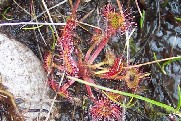
Round-leaved Sundew (Drosera
rotundifolia L.): This minute plant (less than
2 inches in height) is carnivourous. Insects get stuck to
the apparent drops of dew and are digested in place. It does
produce a simple white flower atop a central stalk.
Location: All along the wet spots of Dobbin Grade, Dolly
Sods North, MNF, WV.
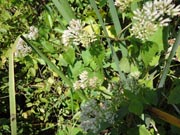
Climbing
Hempweed or Boneset (Mikania scandens): Round
clusters of Boneset-like flowers. Grows in marshy area,
covering other plants. Location: Merkle Wildlife Sanctuary,
MD.
|

